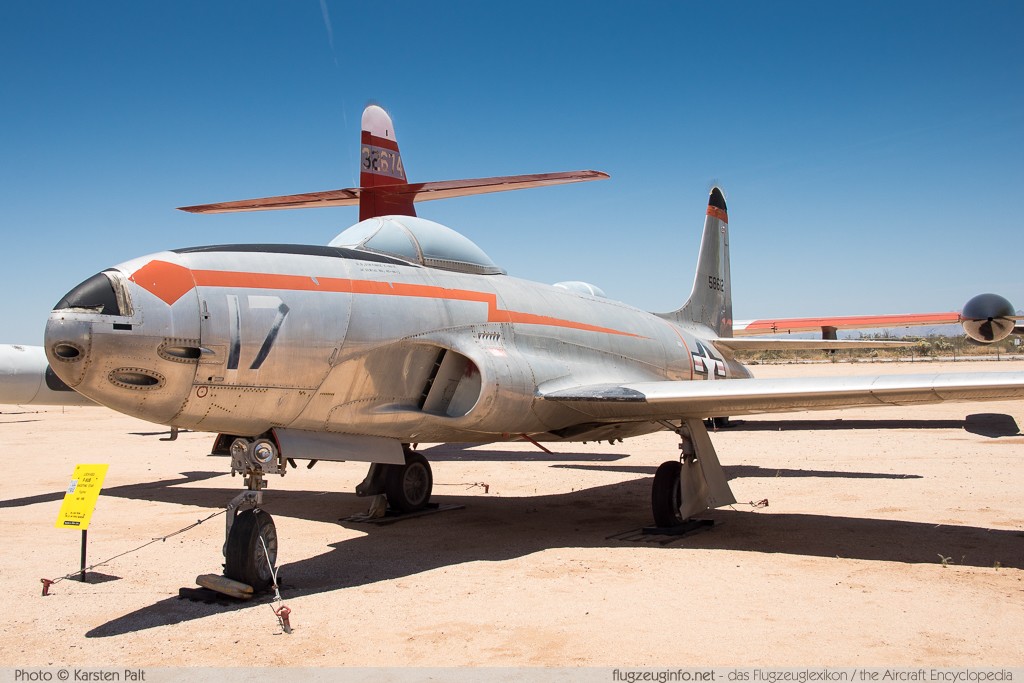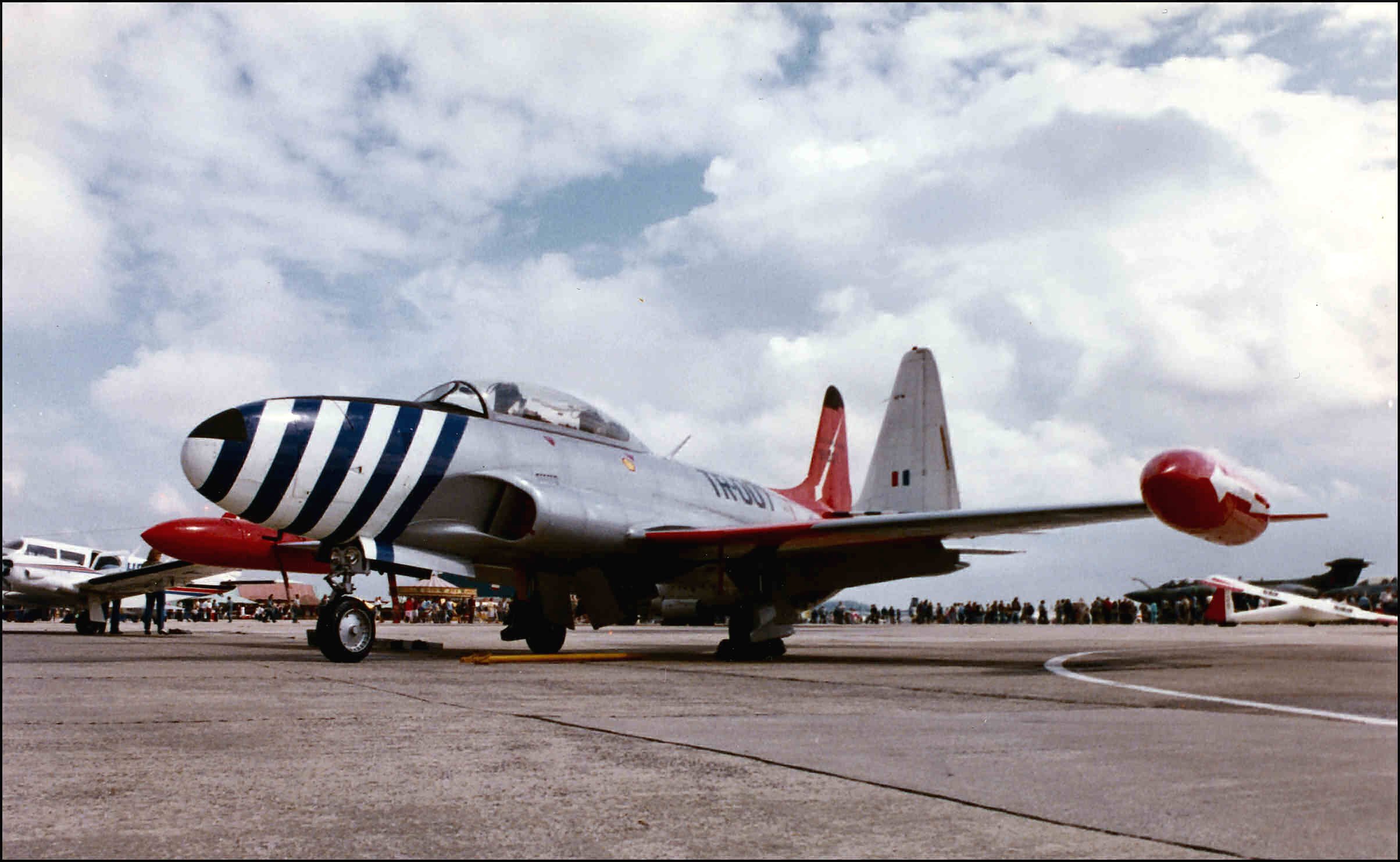Lockheed P80 Shooting Star Great Planes Photo (24573162) Fanpop

Lockheed P80 Shooting Star Great Planes Photo (24573162) Fanpop
The Lockheed P-80 Shooting Star was the first jet fighter used operationally by the United States Army Air Forces. Designed in 1943 as a response to the Germ.

P80 Shooting Star Hangar 47
The story of the P-80 Shooting Star, the only US jet to see action in WW2 during a secret operation in Italy.Dr. Mark Felton is a well-known British historia.

1945 lockheed P80 Shooting Star aircrafts fighter jet Military usair
The P-80 Shooting Star is a story of urgency, ingenu- ity and a timeless design. The aircraft bridged the gap between pistons and jets. The T-33 gave pilots from around the world an education on high speed, high altitude and jet flight. And both met the spirit of Kelly Johnson's notional 17th rule for the Skunk Works: "If it looks good, it.

Lockheed P80 (F80) Shooting Star Specifications Technical Data
The Lockheed P-80 Shooting Star was America's answer to the Messerschmitt Me 262 and the first American combat-ready jet fighter and airplane to exceed 500 mph in level-flight. It made its inaugural flight on January 8, 1944 and entered service in 1945. It did not see combat during World War II, but saw extensive service in Korea.

1945 lockheed P80 Shooting Star aircrafts fighter jet Military usair
The first production P-80As were painted to smooth all skin joints. Painting was later discontinued. Few airplanes in the history of aeronautics have been as successful as the Lockheed P-80 Shooting Star. It was the first American combat-ready jet fighter when it went into service in 1945. It emerged as victor in the world's first all-jet.
.jpg)
How America's P80 Shooting Star Ushered In The Air Force Fighter Jet
In 1947, a P-80 Shooting Star made the first transcontinental nonstop jet flight across the US, a distance of 2,457 in only 4 hours and 13 minutes at an average speed of 584 mph. During the Berlin airlift of 1948, a squadron of the P-80 Shooting Stars were scrambled to defend the transports from Soviet Aggression. They completed the first non.

1945 lockheed P80 Shooting Star aircrafts fighter jet Military usair
by Stephan Wilkinson 12/21/2021. In 1943 it took just 143 days for Lockheed designer Clarence"Kelly" Johnson and his elite team of 128 Skunk Works engineers and fabricators to create the P-80 Shooting Star. But had it not been for the British, all they would have displayed on rollout day was the world's fastest glider. It would have had.

1945 lockheed P80 Shooting Star aircrafts fighter jet Military usair
The Lockheed P-80 Shooting Star, also known as the F-80, was the first jet fighter used operationally by the US Army Air Forces (USAAF). While German jet aircraft, such as the Messerschmitt Me 262, often steal the limelight when discussing World War II-era aviation technology, the P-80 played a significant role in the conflict and helped shape the future of jet aviation.

Lockheed P80 Shooting Star US jet fighter WW2, Korean War
The Lockheed P-80 Shooting Star was a straight-winged jet fighter developed and produced by the American company Lockheed. Introduced in 1945, it was the first jet fighter operated by the United States Army Air Forces. The aircraft was built from 1945 until 1950 with a total number of 1,715 units produced and was retired with the United States in 1959.

1945, Lockheed, P 80, Shooting, Star, Aircrafts, Fighter, Jet, Military
The P-80 Redefines Fast - In the Air and On the Assembly Line. October 01, 2020. During the summer of 1943, Lockheed Chief Engineer Kelly Johnson enlisted an elite team of engineers and shop mechanics to gather in a rented circus tent he had pitched downwind from a noxious plastics factory at the edge of Lockheed's Burbank, Calif., facility.

Project Extraversion P80 Shooting Stars in World War II Defense
The Lockheed P-80 Shooting Star was the first jet fighter used operationally by the United States Army Air Forces during World War II. Designed and built by Lockheed in 1943 and delivered just 143 days from the start of design, production models were flying, and two pre-production models did see very limited service in Italy just before the end of World War II.

P80 Shooting Star Samolotzdjęcia Pinterest Shooting stars
The Lockheed P-80/F-80 Shooting Star is undoubtedly the world's most successful first generation jet-powered fighter. Appearing by the last few months of World War 2, the Shooting Star failed to undertake a single combat sortie in the conflict but would prove her worth in the upcoming Korean War as well as in her two very important derivatives - the two-seat trainer T-33 and the F-94 Starfire.

Lockheed P80 Shooting Star Carolinas Aviation Museum
The Lockheed P-80 Shooting Star was the first jet fighter used operationally by the United States Army Air Forces (USAAF). Designed and built by Lockheed in 1943 and delivered in just 143 days from the start of the design process, production models were flying but not ready for service by the end of World War II. Designed with straight wings, the type saw extensive combat in Korea with the.
Everything's Aircrafts Lockheed P80 (Shooting Star)
The Lockheed P-80 Shooting Star was the first jet fighter used operationally by the United States Army Air Forces (USAAF) during World War II. Designed and built by Lockheed in 1943 and delivered just 143 days from the start of design, production models were flying, and two pre-production models did see very limited service in Italy just before the end of World War II.

1945 lockheed P80 Shooting Star aircrafts fighter jet Military usair
The Lockheed P-80 Shooting Star, also known as the F-80, holds the distinction of being the first operational jet fighter employed by the US Army Air Forces (USAAF). Despite the often-focused.

Military Information House Lockheed P80 Shooting Star
The P-80 Shooting Star goes into design. During the war, the Germans introduced the Messerschmitt Me 262, while the British developed the Gloster Meteor. Looking to keep pace, Lockheed began working on the P-80 Shooting Star. The process, which began in 1943, was rapid.